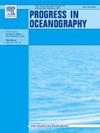挪威海和巴伦支海海洋哺乳动物、鱼类和渔业的食物网评估模型
IF 3.8
3区 地球科学
Q1 OCEANOGRAPHY
引用次数: 0
摘要
挪威海和巴伦支海拥有大量相互影响的商业鱼类种群,以及以浮游生物和鱼类为食的海洋哺乳动物种群。量化这些相互影响的物种以及挪威海和巴伦支海相关渔业过去的动态,对于支持基于生态系统的管理具有重要意义。这项工作的目的是开发一个中等复杂程度的食物网模型,并对 1988-2021 年期间挪威和巴伦支海的生态系统进行定量评估,评估方式应与现有数据和专家知识相一致,并具有内部一致性。为此,我们采用了偶然性与必然性(CaN)建模框架。模型的构建遵循一个迭代过程,该过程允许面对、讨论和解决多个问题,并识别专家知识、数据和输入参数中的不确定性。我们的研究表明,只有认识到某些数据和假设的不确定性比最初想象的要大,才有可能重建食物网过去的动态。根据这项评估,商业鱼类的消费量和渔业捕捞量在 2010 年代初之前一直在共同增长,之后鱼类消费量下降,渔业捕捞量趋于稳定。每年,鱼类平均消耗 1.355 亿吨资源(包括 950 万吨鱼类),海洋哺乳动物平均消耗 2200 万吨,其中 50%(1100 万吨)为鱼类。渔业和狩猎平均捕获了 440 万吨鱼类和 7000 吨海洋哺乳动物。本文章由计算机程序翻译,如有差异,请以英文原文为准。
A food-web assessment model for marine mammals, fish, and fisheries in the Norwegian and Barents Seas
The Norwegian and Barents Seas host large commercial fish populations that interact with each other, as well as marine mammal populations that feed on plankton and fish. Quantifying the past dynamics of these interacting species, and of the associated fisheries in the Norwegian and Barents Sea is of high relevance to support ecosystem-based management. The purpose of this work is to develop a food-web model of intermediate complexity and perform a quantitative assessment of the Norwegian and Barents Sea ecosystems in the period 1988–2021 in a manner that is consistent with existing data and expert knowledge, and that is internally coherent. For this purpose, we use the modelling framework of chance and necessity (CaN). The model construction follows an iterative process that allows to confront, discuss, and resolve multiple issues as well as to recognise uncertainties in expert knowledge, data, and input parameters. We show that it is possible to reconstruct the past dynamics of the food-web only if recognising that some data and assumptions are more uncertain than originally thought. According to this assessment, consumption by commercial fish and catch by fisheries jointly increased until the early 2010s, after which consumption by fish declined and catches by fisheries stabilised. On an annual basis, fish have consumed an average of 135.5 million tonnes of resources (including 9.5 million tonnes of fish), marine mammals have consumed an average of 22 million tonnes of which 50 % (11 million tonnes) were fish. Fisheries and hunting have captured an average of 4.4 million tonnes of fish and 7 thousand tonnes of marine mammals.
求助全文
通过发布文献求助,成功后即可免费获取论文全文。
去求助
来源期刊

Progress in Oceanography
地学-海洋学
CiteScore
7.20
自引率
4.90%
发文量
138
审稿时长
3 months
期刊介绍:
Progress in Oceanography publishes the longer, more comprehensive papers that most oceanographers feel are necessary, on occasion, to do justice to their work. Contributions are generally either a review of an aspect of oceanography or a treatise on an expanding oceanographic subject. The articles cover the entire spectrum of disciplines within the science of oceanography. Occasionally volumes are devoted to collections of papers and conference proceedings of exceptional interest. Essential reading for all oceanographers.
 求助内容:
求助内容: 应助结果提醒方式:
应助结果提醒方式:


